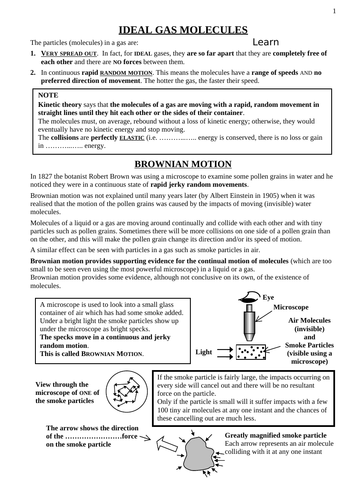







This unit of work consists of four Word documents which require the completion of words, numbers, calculations and graphs.
The first document covers the concept of an ideal gas and how its molecules behave. It explains how Brownian motion is supporting evidence for the particle theory. It also explains how the molecules in a gas exert a pressure on the walls of the container. It relates the average speed of the molecules to the temperature of the gas and it recaps the units of pressure and volume.
The second document covers the concept of absolute zero, the Kelvin scale and its connection to an ideal gas as well as the conversion between Kelvin and Celsius. It also covers the pressure law, namely the pressure of a fixed mass gas at a constant volume is directly proportional to it temperature in Kelvin and p1/T1 = p2/T2. It includes the Kelvin temperature of a gas is directly proportional to the average kinetic energy of its molecules. This is followed by a few questions on converting between Celsius and Kelvin and the use of p1/T1 = p2/T2 showing how to set out the working.
The third document shows how to perform an experiment to give the relationship between the pressure and temperature of a fixed mass of air at constant volume. The students can watch a demonstration, perform the experiment to obtain their own results or they can use the typical results provided to plot a graph which can be extrapolated back to find a value for absolute zero. It also describes the qualitative relationship between pressure and Kelvin temperature for a gas in a sealed container.
The fourth document shows how to perform an experiment to give the relationship between the pressure and volume of a fixed mass of air at constant temperature. Both simplified and more realistic results are given so students can draw conclusions and come up with Boyle’s Law, namely the pressure of a fixed mass gas at a constant temperature is inversely proportional to it volume and p1V1 = p2V2. This is followed by a qualitative explanation of why the pressure rises when a gas is squashed and how this relates to inverse proportion. Finally, there are some questions on the use of p1V1 = p2V2 with an emphasis on how to set out the working.
The next four Word documents have all the answers.
Something went wrong, please try again later.
This resource hasn't been reviewed yet
To ensure quality for our reviews, only customers who have purchased this resource can review it
Report this resourceto let us know if it violates our terms and conditions.
Our customer service team will review your report and will be in touch.
